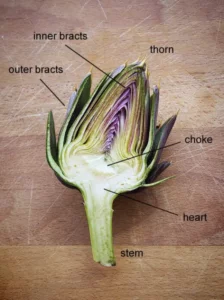Menestra de Primavera (Spring Vegetable Stew)
Gluten Free · Dairy Free · Can be made Vegan Friendly
15 Nov · Written by Raquel Jones

HISTORY & INTERESTING FACTS
I am currently immersed in a love affair with artichokes. These striking vegetables, scientifically known asCynara scolymus, offer a bounty of vitamins and minerals and harbour a host of hidden virtues. There's something profoundly satisfying about taking the time to prepare them from scratch.
Interestingly, the consumption of artichokes tells a culinary tale. Italians lead the pack as the foremost enthusiasts of these green wonders, closely trailed by the Spanish and the French. My recipe harks back to my childhood, where the presence of peas, broad beans, artichokes, and asparagus in our vegetable patch signalled the arrival of spring and the anticipation of warm summer days by the seaside.
Did you know that artichokes are flower buds harvested before they bloom? Once left to blossom, they reveal striking purple-blue flowers.
The Ancient Greeks and Romans considered artichokes a delicacy and believed they possessed aphrodisiac properties.
Feel free to customise this dish by swapping out the vegetables to suit your preferences, but I implore you to keep the artichokes intact. Their natural sweetness is unparalleled, making them utterly irresistible.
This dish is a winner all on its own, accompanied by some delectable, crusty bread. So, whether it's a trip down memory lane or a newfound culinary adventure, I hope you relish this creation as much as I do.
Bon Profit! Raquel x
Menestra de Primavera (Spring Vegetable Stew)
Serves: 4-6 adults
INGREDIENTS
- 600mL chicken/vegetable stock
- 250g of podded broad beans (use fresh or frozen + defrosted)
- 4 artichoke bottoms or baby hearts, halved (use fresh or frozen + defrosted) See how to prepare fresh artichokes below.
- 250g asparagus spears, hard ends removed
- 1/2 a brown onion, peeled and diced
- 2 tbsp EVOO
- 1 garlic clove, peeled and diced
- 2 slices of Spanish jamón or streaky bacon, diced (substitute coconut-bacon for vegans)
- 1.5 tbsp plain flour (GF flour can be used)
- 250mL white wine
- 2 pinches of salt
METHOD
Part 1. Prepare Vegetables
Note: Your aim here is to cook until the vegetables are only tender to retain colour, but if you prefer them softer, cook for longer.
- Bring the stock to the boil in a large pan and add the broad beans. Simmer for 5 mins.
- Then add the artichoke hearts (or bottoms), and simmer for another 5 mins.
- Next, add the asparagus and simmer for a further 5 mins.
- Turn off the heat completely and add the peas.
- After 5-10 minutes resting in the hot stock, strain the vegetables, RESERVING the stock.
Part 2. Prepare Artichokes
Note: Medium/large ‘globe’ artichokes are best.
- Firstly, get a large bowl and fill it with 3 cups of water and 1/2 cup of vinegar.
- Begin by cutting off the stem at the base of the artichoke.
- Peel off the outer and inner leaves/bracts until you reach the heart, dipping the artichoke in the acidulated water from time to time whilst you peel.
- Trim the base and cut around it, removing the remaining leaves/bracts that are harder to peel.
- Scrape away the choke and drop the heart into the acidulated water.
- Continue with the remaining artichokes until you have extracted all hearts and placed them in the water until ready to cook.

Anatomy of an artichoke
Part 3. Prepare Broth
- In a medium fry pan, heat the oil over low heat.
- Fry the onion with a pinch of salt, stirring until soft and translucent. - (you don’t want colour).
- Add the garlic and chopped jamón/streaky bacon, and stir for 1 min.
- Then add the flour and stir until it starts to colour.
- Switch to a whisk and gradually add the wine, whisking vigorously.
- Continue whisking until the sauce thickens a little.
- Add two ladlefuls of the stock from the vegetables and whisk vigorously to avoid lumps forming and cook for 8-10 mins.
- Note: You can add more stock at any time if broth is too thick. You’re after a creamy broth consistency, not a béchamel sauce.
- Add the vegetables to the pan with the sauce and shake to coat. Season further to taste, if required.
Note: At this stage you are only warming the vegetables through before serving. You want the vegetables to remain tender and retain their vibrant colour, but if you prefer them softer, you can cook for longer.
WINE MATCHING & SERVING SUGGESTIONS
Pairing wine with certain foods can indeed be a culinary challenge, and some vegetables, like artichokes, asparagus, broccoli, and brussel sprouts, fall into this category. Their distinctive, somewhat sulphur-like, meaty flavour can clash with many wines, creating an unpleasant taste experience. Additionally, the inherent bitterness in most green vegetables calls for a wine that lacks bitterness.
In such cases, it's often wise to set aside the red wines and opt for a white variety that complements these complex flavours. For example,our chardonnay or pinot griscan be excellent choices.
Also, consider "green" wines, which boast flavours and aromas akin to nettles or grassiness. Ouralbariño, known for its vibrant and fresh notes, is a delightful option that pairs harmoniously with these challenging vegetables.
To enhance your dining experience further, don't forget to serve this dish with a side of freshly baked crusty bread or alongside baked fish or roast chicken or as a centrepiece with buttery polenta.
Liquor Licence Number: 36151142
